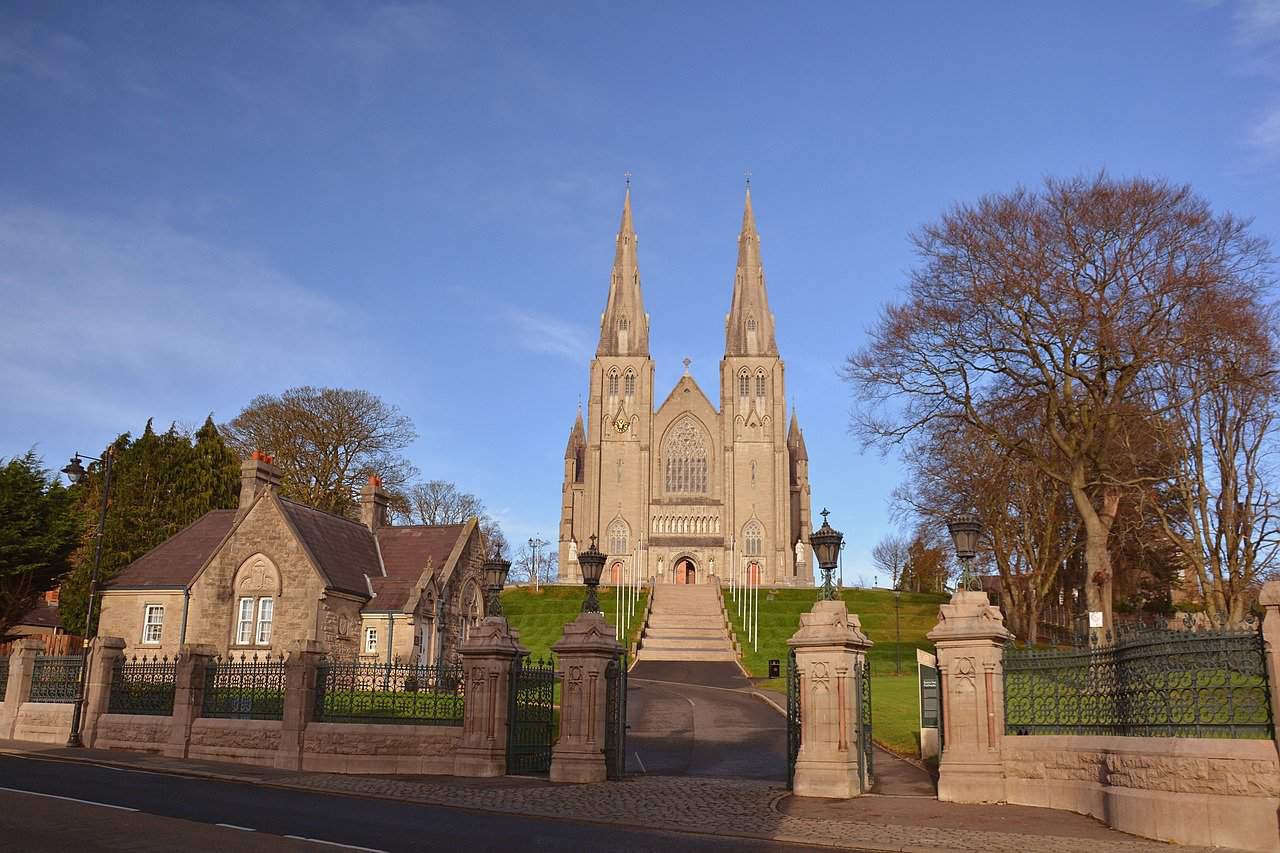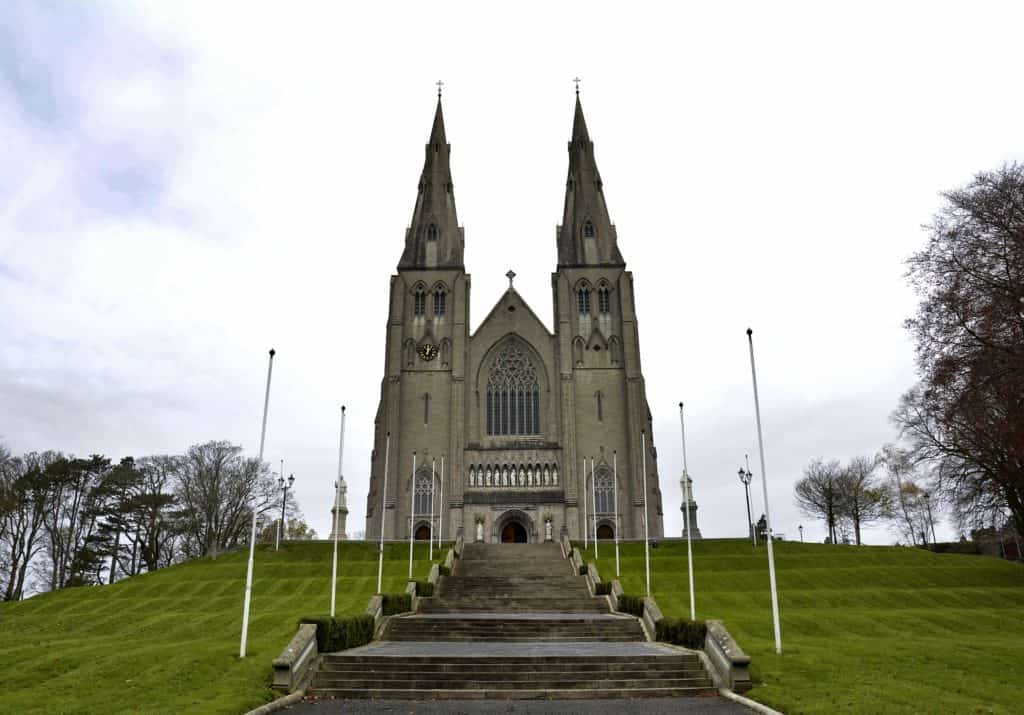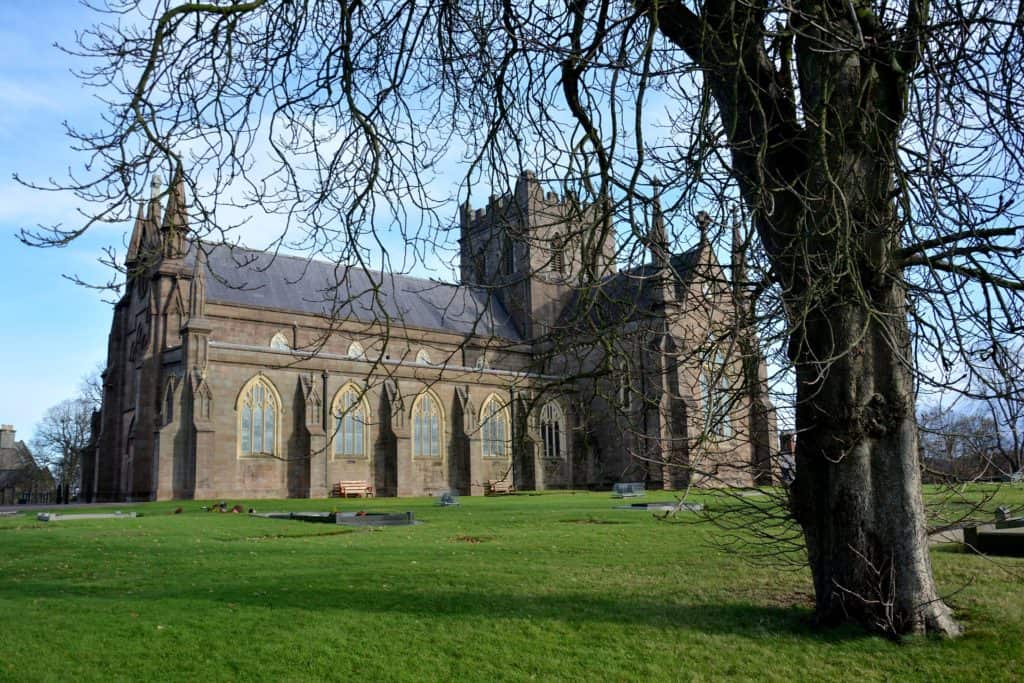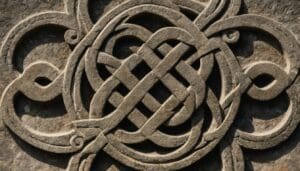12 Interesting Facts About Saint Patrick’s Cathedral – The Cathedral City

Updated On: April 09, 2024 by Ciaran Connolly
Nestled in the heart of Northern Ireland lies Armagh, a city of immense historical and cultural significance, often revered as the ecclesiastical capital of Ireland. At the core of this ancient city is Saint Patrick’s Cathedral, Cathedral City, a beacon of religious and architectural splendour. This article delves into 12 fascinating facts about Saint Patrick’s Cathedral, its deep-rooted history, and the enchanting city of Armagh, uncovering nearby attractions that captivate the hearts of travellers worldwide.
Table of Contents
1. The Tale of Two Cathedrals – Cathedral City
Remarkably, Armagh is home to not one, but two Saint Patrick’s Cathedrals. The uniqueness of this situation is compelling: both a Catholic and an Anglican cathedral, each dedicated to Saint Patrick, stand within the same city. This unusual occurrence highlights the city’s rich religious tapestry and the intertwining of different faith traditions in Irish history.
2. The Ancient Foundations

The history of Saint Patrick’s Cathedral (Catholic) dates back to the 5th century when Saint Patrick himself founded the site. However, the present building’s construction began in 1840. Designed by the renowned architect Thomas Duff, the cathedral stands as a remarkable example of Gothic Revival architecture.
3. The Armagh Observatory
Nearby, the Armagh Observatory, founded in 1789, offers a journey through the stars. As one of the oldest scientific institutions in Northern Ireland, it presents a rich history in astronomy. The beautifully maintained grounds and the Astropark, with its scale models of the Solar System and the Universe, provide a captivating experience for space enthusiasts.
4. The Link to Saint Patrick
Saint Patrick, the patron saint of Ireland, is deeply connected to Armagh. Legend holds that he established his principal church here in the 5th century, solidifying Armagh’s status as the spiritual heart of Ireland. The city is replete with references to Saint Patrick, from ancient sites to modern-day celebrations.
5. Architectural Marvel
The Cathedral’s architecture is a sight to behold. Its spires reach towards the heavens, while its intricate stone carvings and stained glass windows narrate stories from the Bible and Saint Patrick’s life. The interior is equally stunning, with its lofty arches and an ornate altar, embodying the grandeur of the Gothic style.

6. The Saint Patrick’s Day Celebrations
Armagh hosts vibrant Saint Patrick’s Day celebrations, reflecting its connection to the patron saint. Parades, concerts, and cultural events transform the city into a hub of festivity. The cathedral plays a central role in these celebrations, with special services and events that attract visitors from around the world.
7. The Historical Library
The Armagh Robinson Library, near the cathedral, is a treasure trove of knowledge. Founded in 1771, it houses thousands of rare books and ancient manuscripts, including works on theology, science, and the arts. Its collection offers a glimpse into Ireland’s scholarly past.
8. The City’s Roman Roots
Armagh’s history predates the cathedral by centuries. The city’s name, derived from ‘Ard Macha’, is linked to the ancient goddess Macha, highlighting its Celtic origins. The city’s layout, influenced by Roman urban planning, speaks of its historical significance in the early Christian period.
9. The Palace of the Archbishops
The former palace of the Archbishops of Armagh, now the Armagh City Museum, is another site of historical importance. This elegant 18th-century building offers insights into the city’s ecclesiastical history and the role of the Archbishops in shaping regional affairs.
10. The Brian Boru Legacy
Armagh is closely associated with Brian Boru, the legendary High King of Ireland. He is said to have been buried in the city after his death at the Battle of Clontarf in 1014. This connection adds a layer of historical and mythical significance to Armagh, linking it to pivotal moments in Irish history.
11. The Annual John Hewitt Summer School
The city is also a hub for cultural and literary enthusiasts, hosting the John Hewitt Summer School annually. This event celebrates poetry, music, and art, drawing inspiration from Hewitt’s work, which often explored themes related to identity and heritage.
12. The Navan Fort
Just outside Armagh lies the Navan Fort, an ancient ceremonial site. Regarded as one of Ireland’s most important archaeological sites, it offers a unique insight into pre-Christian Ireland. The fort, along with the cathedral, connects visitors to the deep and diverse historical layers of Armagh.
A Deeper Dive into the History of Armagh
To fully appreciate Saint Patrick’s Cathedral and the city of Armagh, it is crucial to delve into the rich and layered history of the area. Armagh’s story is not just of religious significance but also of cultural, political, and social importance, painting a vivid picture of Ireland’s past.
Pre-Christian Armagh
The origins of Armagh can be traced back to ancient times, long before the advent of Christianity in Ireland. The city’s name, derived from ‘Ard Macha’, connects it to the mythological figure Macha, an ancient Irish goddess associated with war, horses, and sovereignty. This connection indicates the city’s early importance as a significant site in the pagan era.
Armagh and Celtic Spirituality
During the Celtic period, Armagh was known for its strong spiritual significance. The druids, the learned class in ancient Celtic cultures, are believed to have had a significant presence in the region. This era set the foundation for the spiritual relevance that Armagh would continue to hold throughout its history.
The Arrival of Christianity
The arrival of Saint Patrick in the 5th century marked a turning point in Armagh’s history. Saint Patrick established his principal church in Armagh, thereby anchoring the city’s reputation as the ecclesiastical capital of Ireland. This was a period of significant transformation, as the city transitioned from its pagan roots to becoming a centre of Christian learning and spirituality.
Armagh in the Middle Ages
The Middle Ages saw Armagh emerge as a key religious and educational centre. It was during this period that the original Saint Patrick’s Cathedral was thought to have been built. The city experienced various Viking raids, yet it remained a place of learning and religious importance, with several schools and monasteries being established.
The Influence of the Archbishops
The role of the Archbishops of Armagh was significant in shaping the city’s history. The Archbishop of Armagh was recognized as the Primate of All Ireland, giving the city a central role in the ecclesiastical hierarchy. The construction of the Archbishop’s Palace in the 18th century was a testament to the power and influence held by the church leaders in Armagh.
Armagh under English Rule
The Tudor conquest of Ireland brought Armagh under English control, leading to significant changes. The city became an important administrative and military centre. The Anglican Church gained prominence, and this period saw the establishment of the second Saint Patrick’s Cathedral (Anglican).
The Plantation and its Impact
The 17th-century Plantation of Ulster significantly impacted Armagh. English and Scottish settlers brought new cultural and religious dynamics to the region. Armagh, as a result, became a melting pot of cultures and religions, which has continued to influence the city’s character to this day.
Armagh in Modern History
In the 19th and 20th centuries, Armagh witnessed significant developments, including the construction of the Catholic Saint Patrick’s Cathedral, a marvel of Gothic Revival architecture. The city played a part in the Irish War of Independence and experienced the impacts of the Northern Ireland conflict, though it largely remained a peaceful centre of spiritual and cultural significance.
Cultural Renaissance
Today, Armagh is experiencing a cultural renaissance, celebrating its rich heritage while looking towards the future. Festivals, educational institutions, and museums play a crucial role in this, showcasing the city’s unique history and its contribution to Irish culture.
Exploring the Key Attractions in Armagh
Armagh, a city steeped in history and culture, offers a wide array of attractions for visitors. Each site provides a unique glimpse into the rich tapestry of the city’s past and present. Let’s explore some of the most significant attractions in Armagh that contribute to its allure as a tourist destination.
1. Saint Patrick’s Cathedrals
Catholic Saint Patrick’s Cathedral: A masterpiece of Gothic Revival architecture, this cathedral stands as a testament to Armagh’s religious significance. Its intricate design and historical artefacts make it a must-visit.
Anglican Saint Patrick’s Cathedral: This medieval cathedral, located on Sally Hill, is a historic landmark with a unique heritage. It houses the tomb of Brian Boru and boasts stunning architecture, including beautiful stained-glass windows.
2. Armagh Planetarium
A state-of-the-art facility, the Armagh Planetarium offers a fascinating journey into space and astronomy. It features interactive exhibits, a digital theatre, and educational programs, making it an exciting destination for all ages.
3. Armagh Robinson Library
One of the oldest libraries in Northern Ireland, this library is a treasure trove of rare books and manuscripts. Its collection includes significant works on Irish history, making it a haven for history buffs and scholars.
4. Navan Centre & Fort
This ancient ceremonial site provides insights into pre-Christian Ireland. The Navan Centre offers interactive exhibits and reenactments, making it an engaging experience for visitors interested in Ireland’s Celtic heritage.
5. Armagh County Museum
As the oldest county museum in Ireland, it offers a rich collection of artefacts that narrate the story of Armagh’s local history. Its exhibits cover natural history, fine arts, and local culture.
6. The Market Place Theatre and Arts Centre
A hub for cultural activities, this modern facility hosts plays, concerts, workshops, and art exhibitions. It’s a focal point for Armagh’s vibrant arts scene, offering entertainment and cultural enrichment.
7. The Mall
A picturesque park in the city centre, The Mall is surrounded by historic buildings and provides a serene escape. It’s ideal for leisurely walks, picnics, and enjoying the tranquil environment of the city.
8. Armagh Public Observatory
Established in the 18th century, this observatory is one of the oldest in the UK and Ireland. It offers educational programs and public observing nights, making it a fascinating destination for astronomy enthusiasts.
9. Saint Patrick’s Trian
A unique visitor complex, Saint Patrick’s Trian houses three main exhibitions that explore the history and legacy of Saint Patrick, the Book of Armagh, and the mythical hero Cú Chulainn.
10. The Archbishop’s Palace
Once the residence of the Archbishops of the Church of Ireland, this 18th-century building now houses administrative offices. The palace gardens and demesne are open to the public, offering a glimpse into the opulent life of the ecclesiastical elite.
11. The Armagh Rhymers
This renowned folk theatre group offers performances throughout the city, especially during festivals. Their performances, rooted in traditional Irish storytelling and music, provide a unique cultural experience.
12. The Gough Barracks
A former British Army barracks, now a military museum, this site provides insights into the military history of Armagh and Northern Ireland. It houses a collection of military memorabilia and exhibits.
In conclusion, Armagh is a city that blends historical significance with cultural vibrancy. Its attractions, ranging from ancient sites to modern theatres and parks, offer something for every visitor. Whether one is drawn to exploring the spiritual heritage, delving into Celtic history, enjoying the arts, or simply relishing the tranquillity of its green spaces, Armagh is a city that captivates and enchants.







Thank you. We will be singing Danny boy here in New York at a parade for St Patrick’s in Rockland County, in the town of Pearl Ruver
Love that 🙂 We hope you had an incredible time!! Saint Patrick’s is a great day out 🙂 Thank you for the comment!